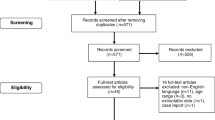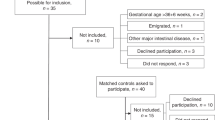Abstract
Summary
We compared bone outcomes in children with breech and cephalic presentation at delivery. Neonatal whole-body bone mineral content (BMC) and area were lower in children with breech presentation. At 4 years, no differences in whole-body or spine measures were found, but hip BMC and area were lower after breech presentation.
Introduction
Breech presentation is associated with altered joint shape and hip dysplasias, but effects on bone mineral content (BMC), area (BA) and density (BMD) are unknown.
Methods
In the prospective Southampton Women’s Survey mother-offspring cohort, whole-body bone outcomes were measured using dual-energy X-ray absorptiometry (DXA) in 1430 offspring, as neonates (mean age 6 days, n = 965, 39 with a breech presentation at birth) and/or at age 4.1 years (n = 999, 39 breech). Hip and spine bone outcomes were also measured at age 4 years.
Results
Neonates with breech presentation had 4.2 g lower whole-body BMC (95% CI −7.4 to − 0.9 g, P = 0.012) and 5.9 cm2 lower BA (− 10.8 to − 1.0 cm2, P = 0.019), but BMD was similar between groups (mean difference − 0.007, − 0.016 to 0.002 g/cm2, P = 0.146) adjusting for sex, maternal smoking, gestational diabetes, mode of delivery, social class, parity, ethnicity, age at scan, birthweight, gestational age and crown-heel length. There were no associations between breech presentation and whole-body outcomes at age 4 years, but, in similarly adjusted models, regional DXA (not available in infants) showed that breech presentation was associated with lower hip BMC (− 0.51, − 0.98 to − 0.04 g, P = 0.034) and BA (− 0.67, − 1.28 to − 0.07 cm2, P = 0.03) but not with BMD (− 0.009, − 0.029 to 0.012 g, P = 0.408), or spine outcomes.
Conclusions
These results suggest that breech presentation is associated with lower neonatal whole-body BMC and BA, which may relate to altered prenatal loading in babies occupying a breech position; these differences did not persist into later childhood. Modest differences in 4-year hip BMC and BA require further investigation.


Similar content being viewed by others
References
Harvey NC, Javaid MK, Arden NK, Poole JR, Crozier SR, Robinson SM, Inskip HM, Godfrey KM, Dennison EM, Cooper C, the SWS Study Team (2010) Maternal predictors of neonatal bone size and geometry: the Southampton Women’s Survey. J Dev Orig Health Dis 1:35–41
Godfrey K, Walker-Bone K, Robinson S, Taylor P, Shore S, Wheeler T, Cooper C (2001) Neonatal bone mass: influence of parental birthweight, maternal smoking, body composition, and activity during pregnancy. J Bone Miner Res 16:1694–1703
Holroyd CR, Osmond C, Barker DJ, Ring SM, Lawlor DA, Tobias JH, Smith GD, Cooper C, Harvey NC (2016) Placental size is associated differentially with postnatal bone size and density. J Bone Miner Res 31:1855–1864
Rogers IS, Ness AR, Steer CD, Wells JC, Emmett PM, Reilly JR, Tobias J, Smith GD (2006) Associations of size at birth and dual-energy X-ray absorptiometry measures of lean and fat mass at 9 to 10 y of age. Am J Clin Nutr 84:739–747
Dennison EM, Syddall HE, Sayer AA, Gilbody HJ, Cooper C (2005) Birth weight and weight at 1 year are independent determinants of bone mass in the seventh decade: the Hertfordshire cohort study. Pediatr Res 57:582–586
Hannam K, Lawlor DA, Tobias JH (2015) Maternal preeclampsia is associated with reduced adolescent offspring hip BMD in a UK population-based birth cohort. J Bone Miner Res 30:1684–1691
Cooper C, Westlake S, Harvey N, Javaid K, Dennison E, Hanson M (2006) Review: developmental origins of osteoporotic fracture. Osteoporos Int 17:337–347
Ireland A, Rittweger J, Schönau E, Lamberg-Allardt C, Viljakainen H (2014) Time since onset of walking predicts tibial bone strength in early childhood. Bone 68:76–84
Ireland A, Maden-Wilkinson T, McPhee J, Cooke K, Narici M, Degens H, Rittweger J (2013) Upper limb muscle-bone asymmetries and bone adaptation in elite youth tennis players. Med Sci Sports Exerc 45:1749–1758
Sayers A, Deere K, Tobias JH (2015) The effect of vigorous physical activity and body composition on cortical bone mass in adolescence. J Bone Miner Res 30:584
Ireland A, Sayers A, Deere KC, Emond A, Tobias JH (2016) Motor competence in early childhood is positively associated with bone strength in late adolescence. J Bone Miner Res 31:1089–1098
Ireland A, Muthuri S, Rittweger J, Adams JE, Ward KA, Kuh D, Cooper R (2017) Later age at onset of independent walking is associated with lower bone strength at fracture-prone sites in older men. J Bone Miner Res 32:1209–1217
Hannam K, Deere KC, Hartley A, Al-Sari UA, Clark EM, Fraser WD, Tobias JH (2017) Habitual levels of higher, but not medium or low, impact physical activity are positively related to lower limb bone strength in older women: findings from a population-based study using accelerometers to classify impact magnitude. Osteoporos Int 28:2813–2822
Johansson J, Nordström A, Nordström P (2015) Objectively measured physical activity is associated with parameters of bone in 70-year-old men and women. Bone 81:72–79
Sival DA, Prechtl HF, Sonder GH, Touwen BC (1993) The effect of intra-uterine breech position on postnatal motor functions of the lower limbs. Early Hum Dev 32:161–176
Miller E, Kouam L (1981) Zur Haufigkeit von Beckenendlagen im Verlauf Der Schwangerschaft und zum Zeitpunkt der Geburt. Zentralbl Gynakol 103:105–109
Cammu H, Dony N, Martens G, Colman R (2014) Common determinants of breech presentation at birth in singletons: a population-based study. Eur J Obstet Gynecol Reprod Biol 177:106–109
Verbruggen SW, Kainz B, Shelmerdine SC, Hajnal JV, Rutherford MA, Arthurs OJ, Phillips AT, Nowlan NC (2018) Stresses and strains on the human fetal skeleton during development. Journal of The Royal Society Interface
Bartlett D, Okun N (1994) Breech presentation: a random event or an explainable phenomenon? Dev Med Child Neurol 36:833–838
Fong BF, Savelsbergh GJ, de Vries JI (2009) Fetal leg posture in uncomplicated breech and cephalic pregnancies. Eur J Pediatr 168:443–447
Andersen GL, Irgens LM, Skranes J, Salvesen KA, Meberg A, Vik T (2009) Is breech presentation a risk factor for cerebral palsy? A Norwegian birth cohort study. Dev Med Child Neurol 51:860–865
Nowlan NC, Sharpe J, Roddy KA, Prendergast PJ, Murphy P (2010) Mechanobiology of embryonic skeletal development: insights from animal models. Birth Defects Res C Embryo Today 90:203–213
Giorgi M, Carriero A, Shefelbine SJ, Nowlan NC (2015) Effects of normal and abnormal loading conditions on morphogenesis of the prenatal hip joint: application to hip dysplasia. J Biomech 48:3390–3397
Chan A, McCaul KA, Cundy PJ, Haan EA, Byron-Scott R (1997) Perinatal risk factors for developmental dysplasia of the hip. Arch Dis Child Fetal Neonatal Ed 76:F94–F100
Hinderaker T, Uden A, Reikerås O (1994) Direct ultrasonographic measurement of femoral anteversion in newborns. Skelet Radiol 23:133–135
Tshorny M, Mimouni FB, Littner Y, Alper A, Mandel D (2007) Decreased neonatal tibial bone ultrasound velocity in term infants born after breech presentation. J Perinatol 27:693–696
World Health Organisation (2006) WHO child growth standards: length/height for age, weight-for-age, weight-for-length, weight-for-height and body mass index-for-age, methods and development. World Health Organization, Geneva
Hinderaker T, Daltveit AK, Irgens LM, Udén A, Reikerås O (1994) The impact of intra-uterine factors on neonatal hip instability. An analysis of 1,059,479 children in Norway. Acta Orthop Scand 65:239–242
Luterkort M, Persson PH, Weldner BM (1984) Maternal and fetal factors in breech presentation. Obstet Gynecol 64:55–59
Moessinger AC, Blanc WA, Marone PA, Polsen DC (1982) Umbilical cord length as an index of fetal activity: experimental study and clinical implications. Pediatr Res 16:109–112
Wright D, Chan GM (2009) Fetal bone strength and umbilical cord length. J Perinatol 29:603–605
Soernes T, Bakke T (1986) The length of the human umbilical cord in vertex and breech presentations. Am J Obstet Gynecol 154:1086–1087
Hofmeyr GJ, Kulier R, West HM (2015) External cephalic version for breech presentation at term Cochrane Database Syst Rev CD000083
Lambeek AF, De Hundt M, Vlemmix F, Akerboom BM, Bais JM, Papatsonis DN, Mol BW, Kok M (2013) Risk of developmental dysplasia of the hip in breech presentation: the effect of successful external cephalic version. BJOG 120:607–612
Suzuki S, Yamamuro T (1985) Fetal movement and fetal presentation. Early Hum Dev 11:255–263
Witkop CT, Zhang J, Sun W, Troendle J (2008) Natural history of fetal position during pregnancy and risk of nonvertex delivery. Obstet Gynecol 111:875–880
Harvey NC, Cole ZA, Crozier SR et al (2012) Physical activity, calcium intake and childhood bone mineral: a population-based cross-sectional study. Osteoporos Int 23:121–130
Janz KF, Burns TL, Torner JC, Levy SM, Paulos R, Willing MC, Warren JJ (2001) Physical activity and bone measures in young children: the Iowa bone development study. Pediatrics 107:1387–1393
Johannsen N, Binkley T, Englert V, Neiderauer G, Specker B (2003) Bone response to jumping is site-specific in children: a randomized trial. Bone 33:533–539
Funding
KMG is supported by the UK Medical Research Council (MC_UU_12011/4), the National Institute for Health Research (as an NIHR Senior Investigator (NF-SI-0515-10042) and through the NIHR Southampton Biomedical Research Centre) and the European Union’s Erasmus+ Capacity-Building ENeASEA Project. The work was supported by the European Union’s Seventh Framework Programme (FP7/2007-2013), projects EarlyNutrition and ODIN under grant agreement numbers 289346 and 613977, and the ALPHABET project [an award made through the ERA-Net on Biomarkers for Nutrition and Health (ERA HDHL)], Horizon 2020 grant agreement number 696295 (UK component: BBSRC: BB/P028179/1). HMI is supported by the UK Medical Research Council (MC_UU_12011.4). This work was supported by grants from the Medical Research Council, British Heart Foundation, Arthritis Research UK, National Institute for Health Research (NIHR) Southampton Biomedical Research Centre, University of Southampton and University Hospital Southampton NHS Foundation Trust, Nestec and NIHR Biomedical Research Centre, University of Oxford.
Author information
Authors and Affiliations
Corresponding author
Ethics declarations
The study was approved by Southampton and Southwest Hampshire Local Research Ethics Committee (approval numbers 267/97, 307/97, 153/99 and 005/03/t) and parental informed consent was given at both scan timepoints.
Conflicts of interest
None.
Electronic supplementary material
Fig. S1
(PPTX 68.7 kb)
Rights and permissions
About this article
Cite this article
Ireland, A., Crozier, S.R., Heazell, A.E.P. et al. Breech presentation is associated with lower bone mass and area: findings from the Southampton Women’s Survey. Osteoporos Int 29, 2275–2281 (2018). https://doi.org/10.1007/s00198-018-4626-2
Received:
Accepted:
Published:
Issue Date:
DOI: https://doi.org/10.1007/s00198-018-4626-2




